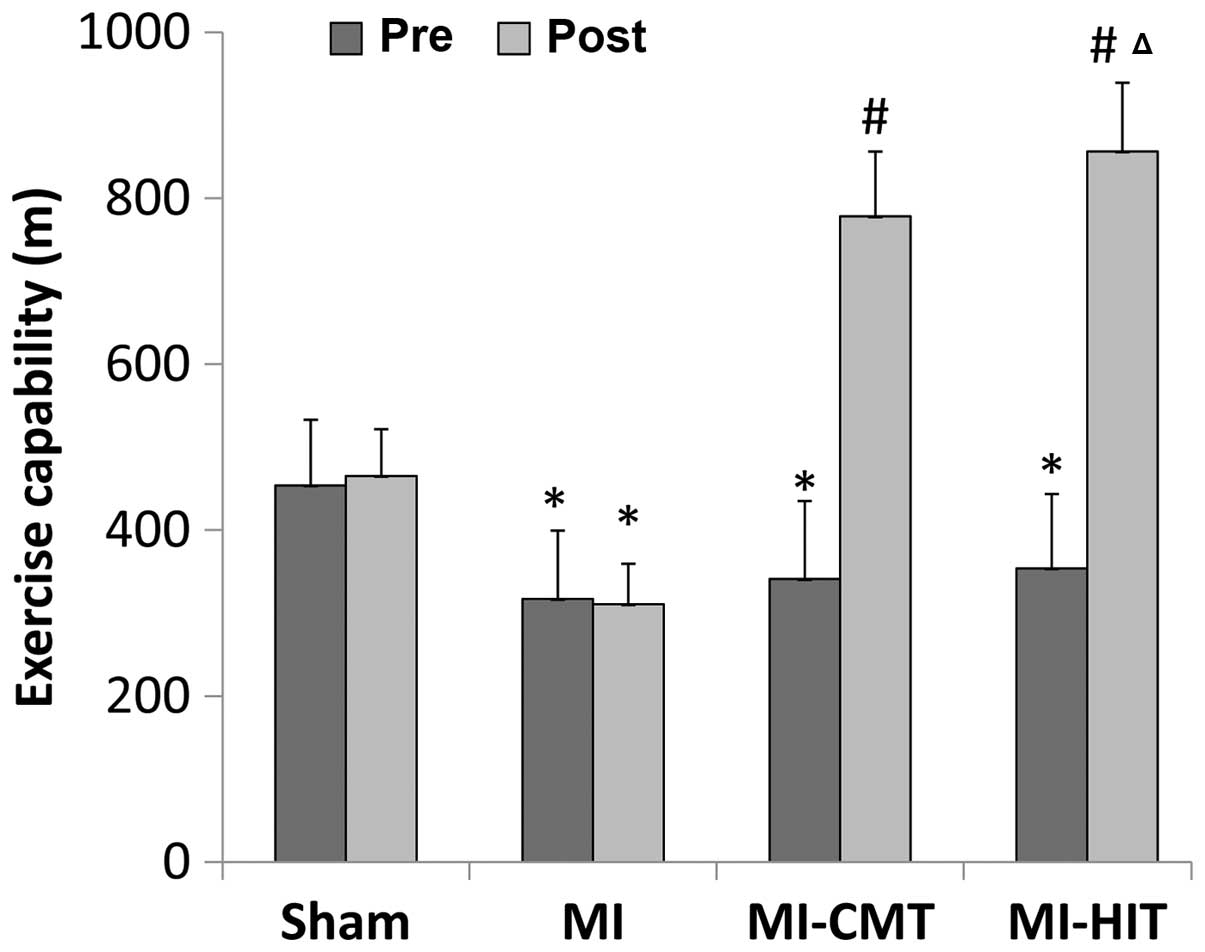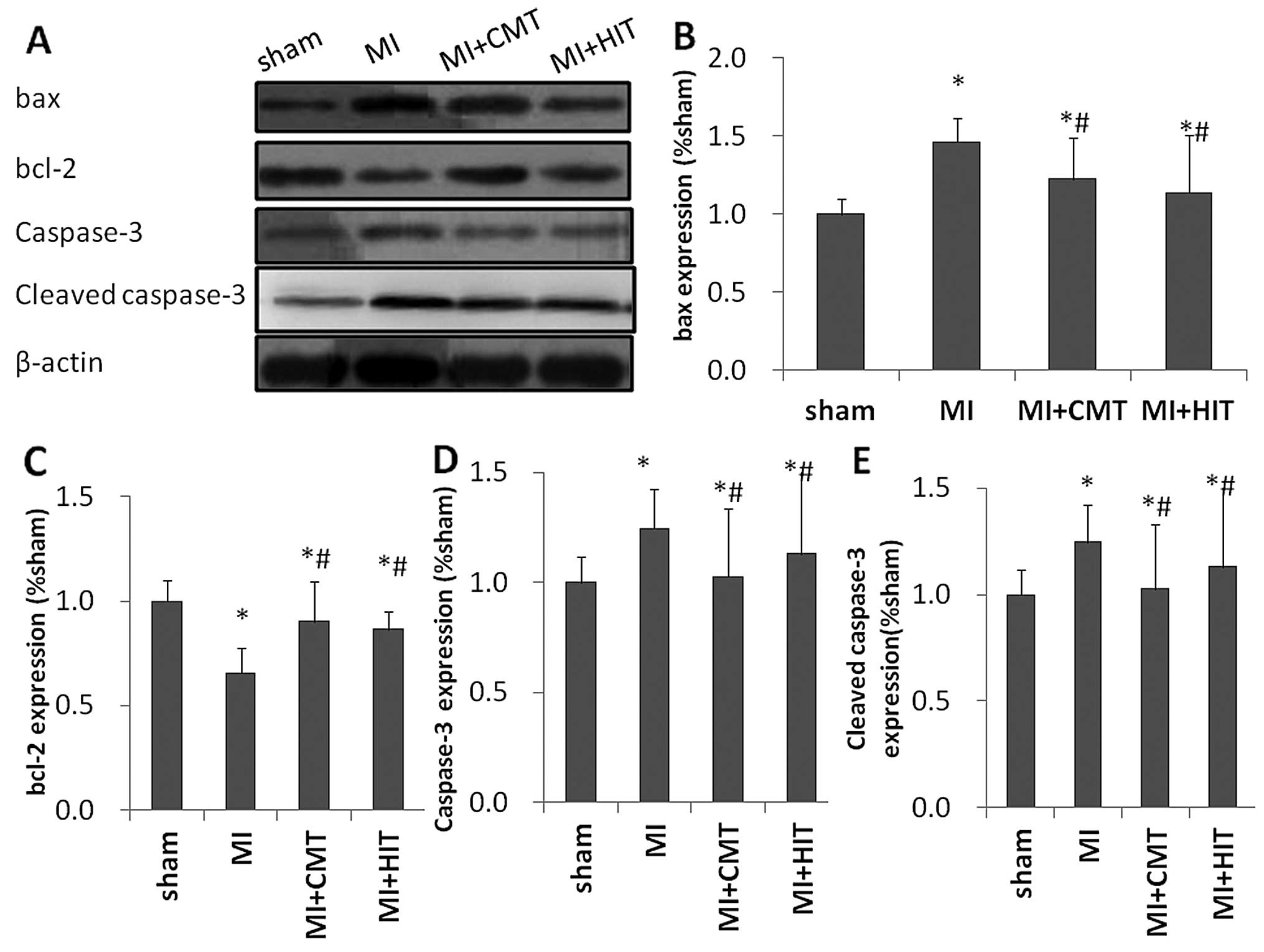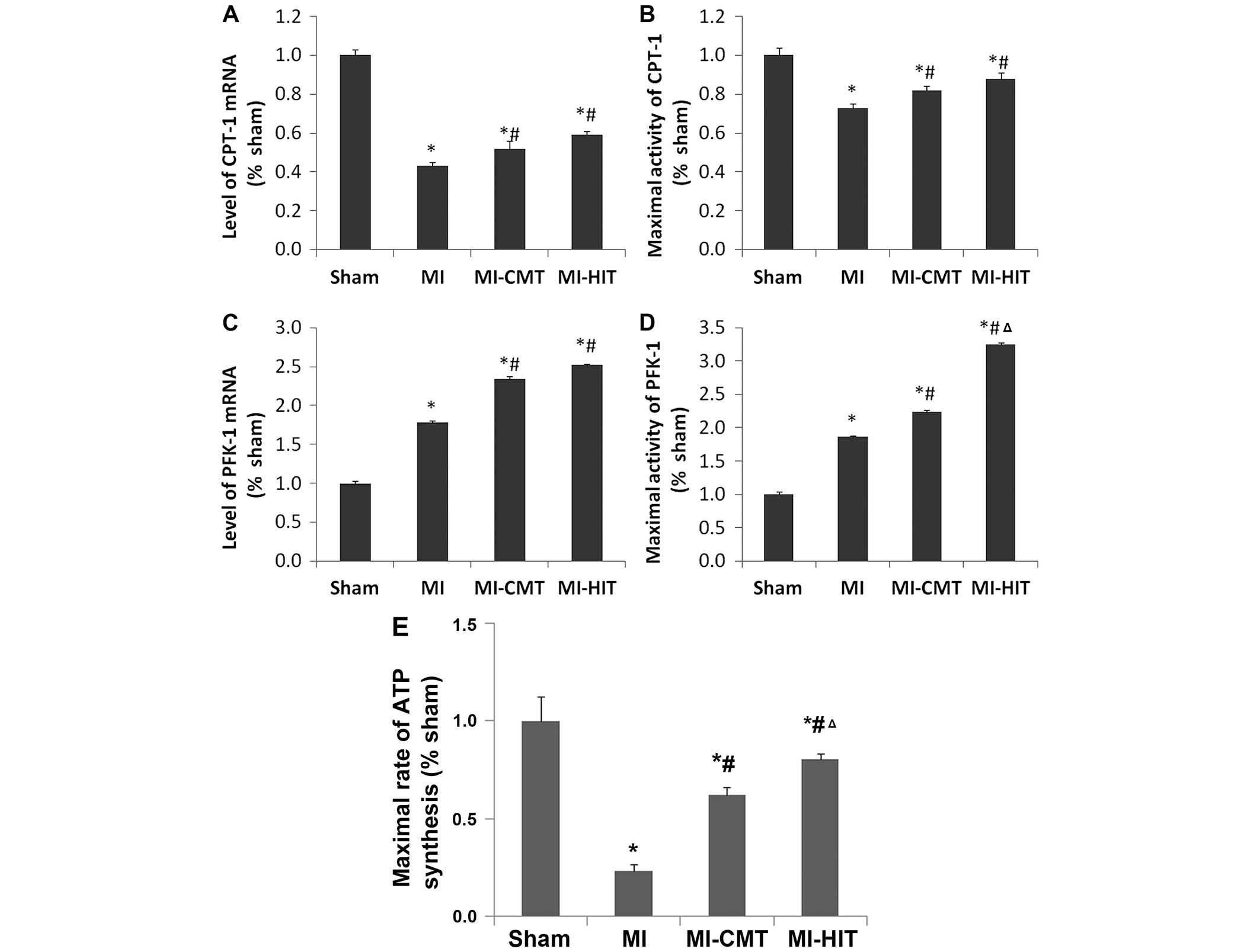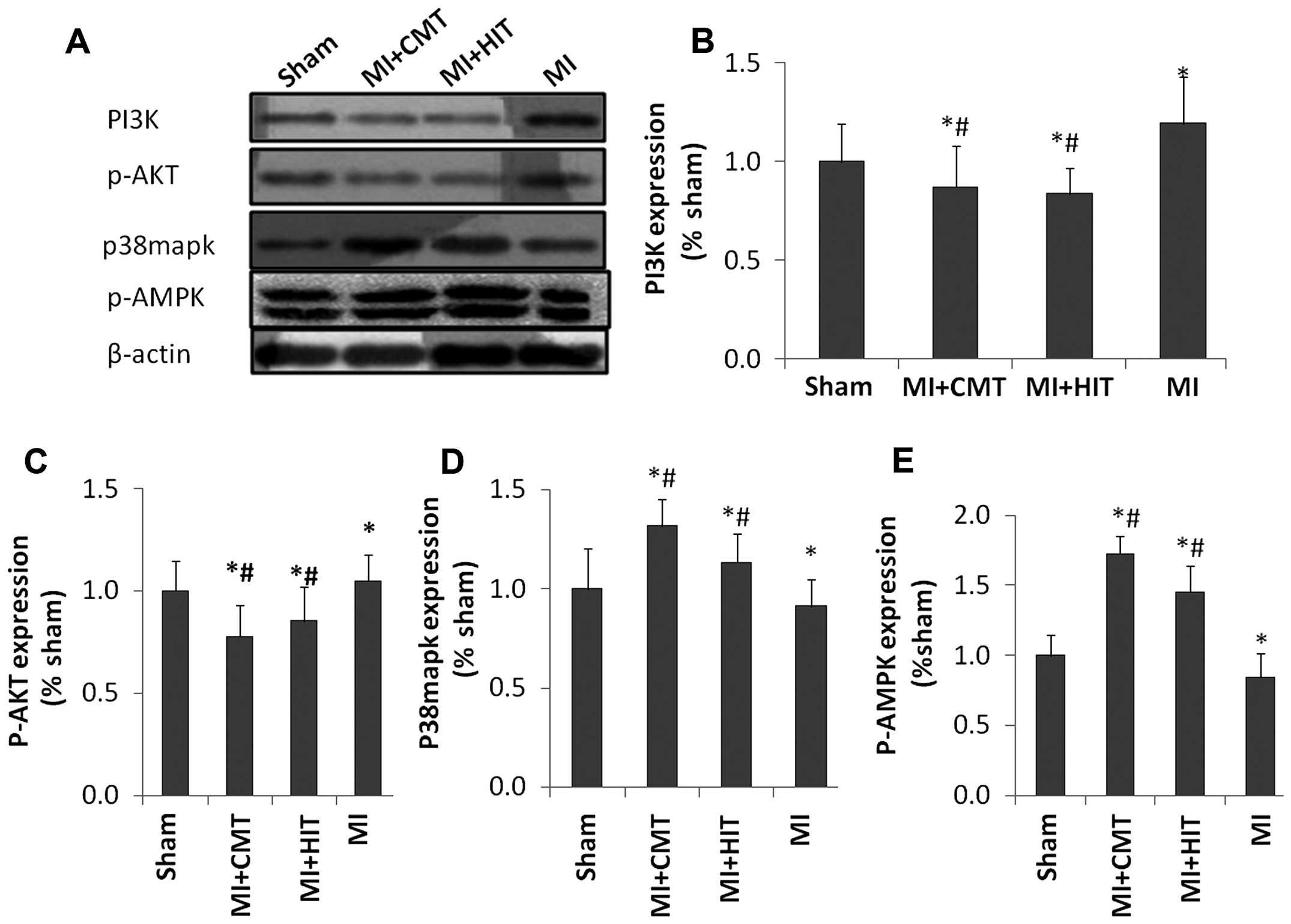|
1
|
Nagayama M, Itoh H and Maeda T: Cardiac
rehabilitation for patients with acute myocardial infarction. Nihon
Rinsho. 69(Suppl 9): S203–S209. 2011.In Japanese.
|
|
2
|
Achttien RJ, Staal JB, van der Voort S, et
al Practice Recommendations Development Group: Exercise-based
cardiac rehabilitation in patients with coronary heart disease: a
practice guideline. Neth Heart J. 21:429–438. 2013. View Article : Google Scholar : PubMed/NCBI
|
|
3
|
Oldridge N: Exercise-based cardiac
rehabilitation in patients with coronary heart disease:
meta-analysis outcomes revisited. Future Cardiol. 8:729–751. 2012.
View Article : Google Scholar : PubMed/NCBI
|
|
4
|
Moholdt T, Aamot IL, Granøien I, et al:
Aerobic interval training increases peak oxygen uptake more than
usual care exercise training in myocardial infarction patients: a
randomized controlled study. Clin Rehabil. 26:33–44. 2012.
View Article : Google Scholar
|
|
5
|
Moholdt T, Aamot IL, Granøien I, et al:
Long-term follow-up after cardiac rehabilitation: a randomized
study of usual care exercise training versus aerobic interval
training after myocardial infarction. Int J Cardiol. 152:388–390.
2011. View Article : Google Scholar : PubMed/NCBI
|
|
6
|
Maiorana A: Interval training confers
greater gains than continuous training in people with heart
failure. J Physiother. 58:1992012. View Article : Google Scholar : PubMed/NCBI
|
|
7
|
Kemi OJ and Wisløff U: Mechanisms of
exercise-induced improvements in the contractile apparatus of the
mammalian myocardium. Acta Physiol (Oxf). 199:425–439. 2010.
View Article : Google Scholar
|
|
8
|
Garza MA, Wason EA and Zhang JQ: Cardiac
remodeling and physical training post myocardial infarction. World
J Cardiol. 7:52–64. 2015. View Article : Google Scholar : PubMed/NCBI
|
|
9
|
Kida K, Osada N, Akashi YJ, Sekizuka H,
Omiya K and Miyake F: The exercise training effects of skeletal
muscle strength and muscle volume to improve functional capacity in
patients with myocardial infarction. Int J Cardiol. 129:180–186.
2008. View Article : Google Scholar : PubMed/NCBI
|
|
10
|
Moreira JB, Bechara LR, Bozi LH, et al:
High-versus moderate-intensity aerobic exercise training effects on
skeletal muscle of infarcted rats. J Appl Physiol (1985).
114:1029–1041. 2013. View Article : Google Scholar
|
|
11
|
Lee Y and Gustafsson AB: Role of apoptosis
in cardiovascular disease. Apoptosis. 14:536–548. 2009. View Article : Google Scholar : PubMed/NCBI
|
|
12
|
Tullio F, Angotti C, Perrelli MG, Penna C
and Pagliaro P: Redox balance and cardioprotection. Basic Res
Cardiol. 108:3922013. View Article : Google Scholar : PubMed/NCBI
|
|
13
|
Quindry JC, Hamilton KL, French JP, et al:
Exercise-induced HSP-72 elevation and cardioprotection against
infarct and apoptosis. J Appl Physiol 1985. 103:1056–1062. 2007.
View Article : Google Scholar : PubMed/NCBI
|
|
14
|
Chen TI, Shen YJ, Wang IC and Yang KT:
Short-term exercise provides left ventricular myocardial protection
against intermittent hypoxia-induced apoptosis in rats. Eur J Appl
Physiol. 111:1939–1950. 2011. View Article : Google Scholar : PubMed/NCBI
|
|
15
|
Wambolt RB, Lopaschuk GD, Brownsey RW and
Allard MF: Dichloroacetate improves postischemic function of
hypertrophied rat hearts. J Am Coll Cardiol. 36:1378–1385. 2000.
View Article : Google Scholar : PubMed/NCBI
|
|
16
|
Lopaschuk GD, Spafford MA, Davies NJ and
Wall SR: Glucose and palmitate oxidation in isolated working rat
hearts reperfused after a period of transient global ischemia. Circ
Res. 66:546–553. 1990. View Article : Google Scholar : PubMed/NCBI
|
|
17
|
Egstrup M, Kistorp CN, Schou M, et al:
Abnormal glucose metabolism is associated with reduced left
ventricular contractile reserve and exercise intolerance in
patients with chronic heart failure. Eur Heart J Cardiovasc
Imaging. 14:349–357. 2013. View Article : Google Scholar
|
|
18
|
Reichkendler MH, Auerbach P, Rosenkilde M,
et al: Exercise training favors increased insulin-stimulated
glucose uptake in skeletal muscle in contrast to adipose tissue: a
randomized study using FDG PET imaging. Am J Physiol Endocrinol
Metab. 305:E496–E506. 2013. View Article : Google Scholar : PubMed/NCBI
|
|
19
|
Bourlier V, Saint-Laurent C, Louche K, et
al: Enhanced glucose metabolism is preserved in cultured primary
myotubes from obese donors in response to exercise training. J Clin
Endocrinol Metab. 98:3739–3747. 2013. View Article : Google Scholar : PubMed/NCBI
|
|
20
|
Castorena CM, Arias EB, Sharma N and
Cartee GD: Postexercise improvement in insulin-stimulated glucose
uptake occurs concomitant with greater AS160 phosphorylation in
muscle from normal and insulin-resistant rats. Diabetes.
63:2297–2308. 2014. View Article : Google Scholar : PubMed/NCBI
|
|
21
|
Franke TF, Hornik CP, Segev L, Shostak GA
and Sugimoto C: PI3K/Akt and apoptosis: size matters. Oncogene.
22:8983–8998. 2003. View Article : Google Scholar : PubMed/NCBI
|
|
22
|
Blanc A, Pandey NR and Srivastava AK:
Synchronous activation of ERK 1/2, p38mapk and PKB/Akt signaling by
H2O2 vascular smooth muscle cells: Potential
involvement in vascular in disease (Review). Int J Mol Med.
11:229–234. 2003.PubMed/NCBI
|
|
23
|
Bijland S, Mancini SJ and Salt IP: Role of
AMP-activated protein kinase in adipose tissue metabolism and
inflammation. Clin Sci (Lond). 124:491–507. 2013. View Article : Google Scholar
|
|
24
|
Pfeffer MA, Pfeffer JM, Fishbein MC, et
al: Myocardial infarct size and ventricular function in rats. Circ
Res. 44:503–512. 1979. View Article : Google Scholar : PubMed/NCBI
|
|
25
|
Høydal MA, Wisløff U, Kemi OJ and
Ellingsen O: Running speed and maximal oxygen uptake in rats and
mice: practical implications for exercise training. Eur J
Cardiovasc Prev Rehabil. 14:753–760. 2007. View Article : Google Scholar : PubMed/NCBI
|
|
26
|
Kraljevic J, Marinovic J, Pravdic D, et
al: Aerobic interval training attenuates remodelling and
mitochondrial dysfunction in the post-infarction failing rat heart.
Cardiovasc Res. 99:55–64. 2013. View Article : Google Scholar : PubMed/NCBI
|
|
27
|
Pauly DF and McMillin JB: Importance of
acyl-CoA availability in interpretation of carnitine
palmitoyltransferase I kinetics. J Biol Chem. 263:18160–18167.
1988.PubMed/NCBI
|
|
28
|
Dumas JF, Goupille C, Julienne CM, et al:
Efficiency of oxidative phosphorylation in liver mitochondria is
decreased in a rat model of peritoneal carcinosis. J Hepatol.
54:320–327. 2011. View Article : Google Scholar
|
|
29
|
Zhang KR, Liu HT, Zhang HF, et al:
Long-term aerobic exercise protects the heart against
ischemia/reperfusion injury via PI3 kinase-dependent and
Akt-mediated mechanism. Apoptosis. 12:1579–1588. 2007. View Article : Google Scholar : PubMed/NCBI
|
|
30
|
Powers SK, Criswell D, Lawler J, et al:
Rigorous exercise training increases superoxide dismutase activity
in ventricular myocardium. Am J Physiol. 265(6 Pt 2): H2094–H2098.
1993.PubMed/NCBI
|
|
31
|
Jiang HK, Miao Y, Wang YH, et al: Aerobic
interval training protects against myocardial infarction-induced
oxidative injury by enhancing antioxidase system and mitochondrial
biosyn-thesis. Clin Exp Pharmacol Physiol. 41:192–201. 2014.
View Article : Google Scholar : PubMed/NCBI
|
|
32
|
Barbosa VA, Luciano TF, Vitto MF, et al:
Exercise training plays cardioprotection through the oxidative
stress reduction in obese rats submitted to myocardial infarction.
Int J Cardiol. 157:422–424. 2012. View Article : Google Scholar : PubMed/NCBI
|
|
33
|
Pinho CA, Tromm CB, Tavares AM, et al:
Effects of different physical training protocols on ventricular
oxidative stress parameters in infarction-induced rats. Life Sci.
90:553–559. 2012. View Article : Google Scholar : PubMed/NCBI
|
|
34
|
Frederico MJ, Justo SL, Da Luz G, et al:
Exercise training provides cardioprotection via a reduction in
reactive oxygen species in rats submitted to myocardial infarction
induced by isoproterenol. Free Radic Res. 43:957–964. 2009.
View Article : Google Scholar : PubMed/NCBI
|
|
35
|
Broderick TL, Poirier P and Gillis M:
Exercise training restores abnormal myocardial glucose utilization
and cardiac function in diabetes. Diabetes Metab Res Rev. 21:44–50.
2005. View
Article : Google Scholar
|
|
36
|
Burelle Y, Wambolt RB, Grist M, et al:
Regular exercise is associated with a protective metabolic
phenotype in the rat heart. Am J Physiol Heart Circ Physiol.
287:H1055–H1063. 2004. View Article : Google Scholar : PubMed/NCBI
|
|
37
|
Garvey WT, Hardin D, Juhaszova M and
Dominguez JH: Effects of diabetes on myocardial glucose transport
system in rats: implications for diabetic cardiomyopathy. Am J
Physiol. 264(3 Pt 2): H837–H844. 1993.PubMed/NCBI
|
|
38
|
Richter EA and Hargreaves M: Exercise,
GLUT4 and skeletal muscle glucose uptake. Physiol Rev. 93:993–1017.
2013. View Article : Google Scholar : PubMed/NCBI
|
|
39
|
Hardie DG and Pan DA: Regulation of fatty
acid synthesis and oxidation by the AMP-activated protein kinase.
Biochem Soc Trans. 30:1064–1070. 2002. View Article : Google Scholar : PubMed/NCBI
|
|
40
|
Zonderland ML, Bär PR, Reijneveld JC,
Spruijt BM, Keizer HA and Glatz JF: Different metabolic adaptation
of heart and skeletal muscles to moderate-intensity treadmill
training in the rat. Eur J Appl Physiol Occup Physiol. 79:391–396.
1999. View Article : Google Scholar : PubMed/NCBI
|














